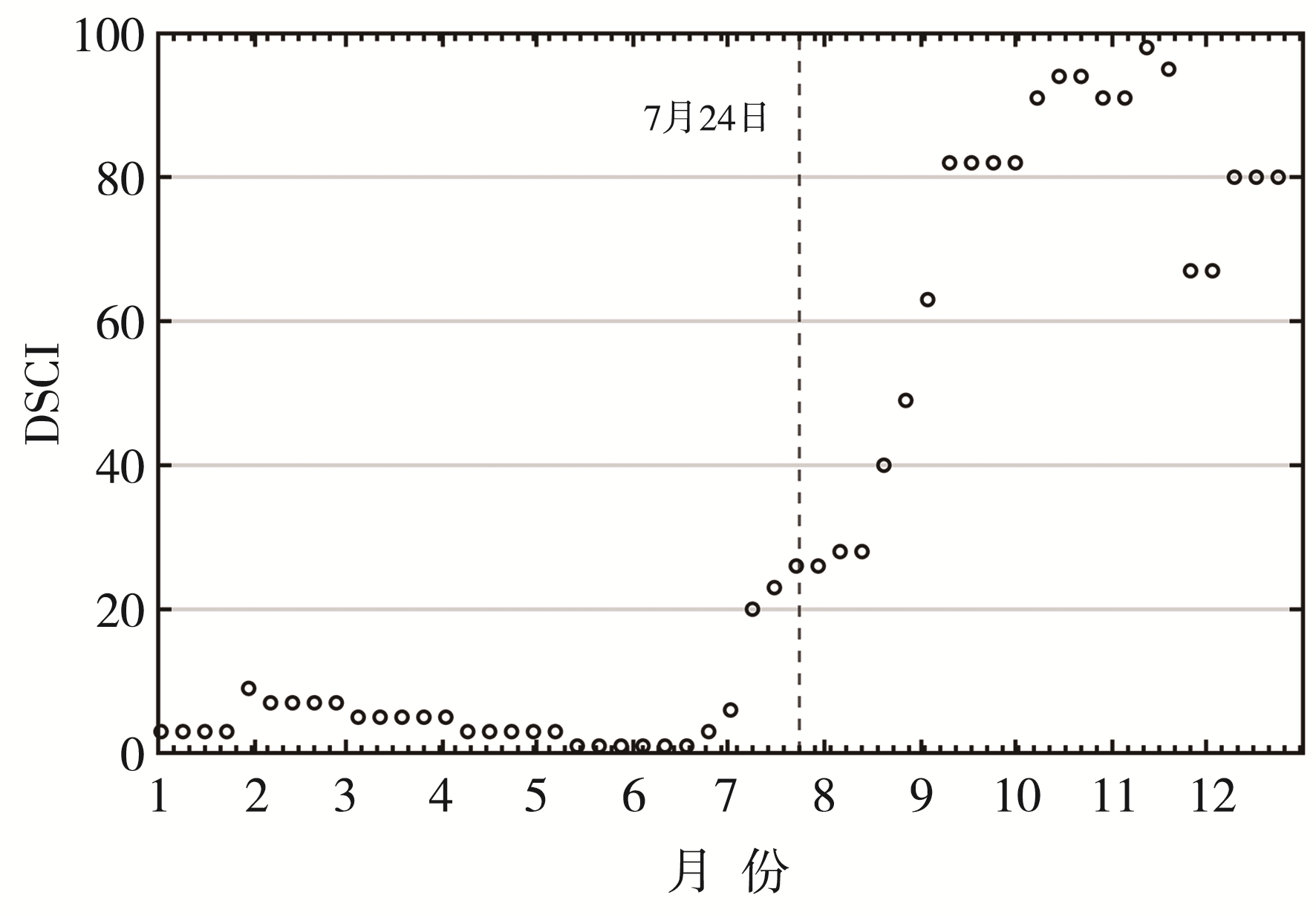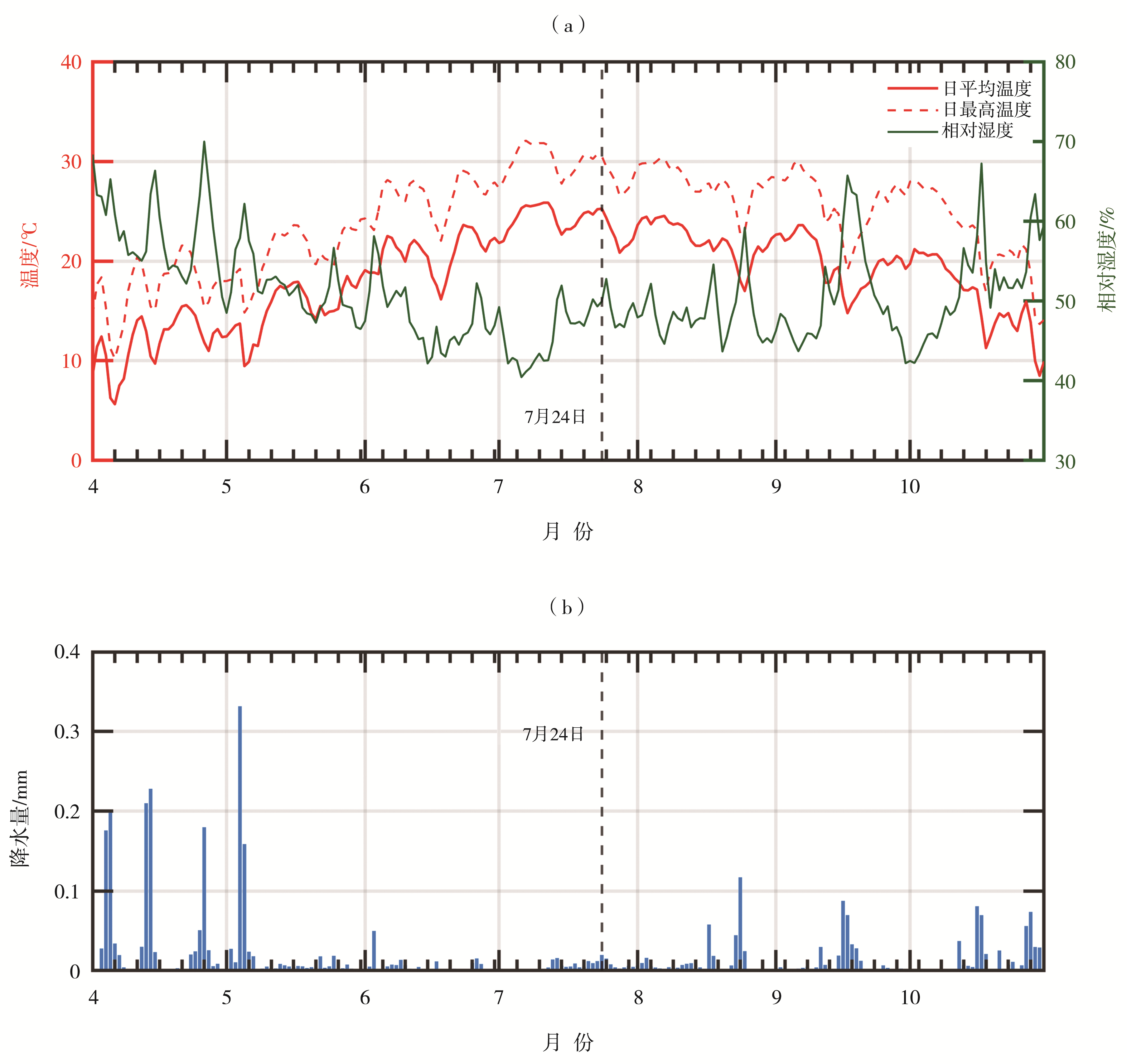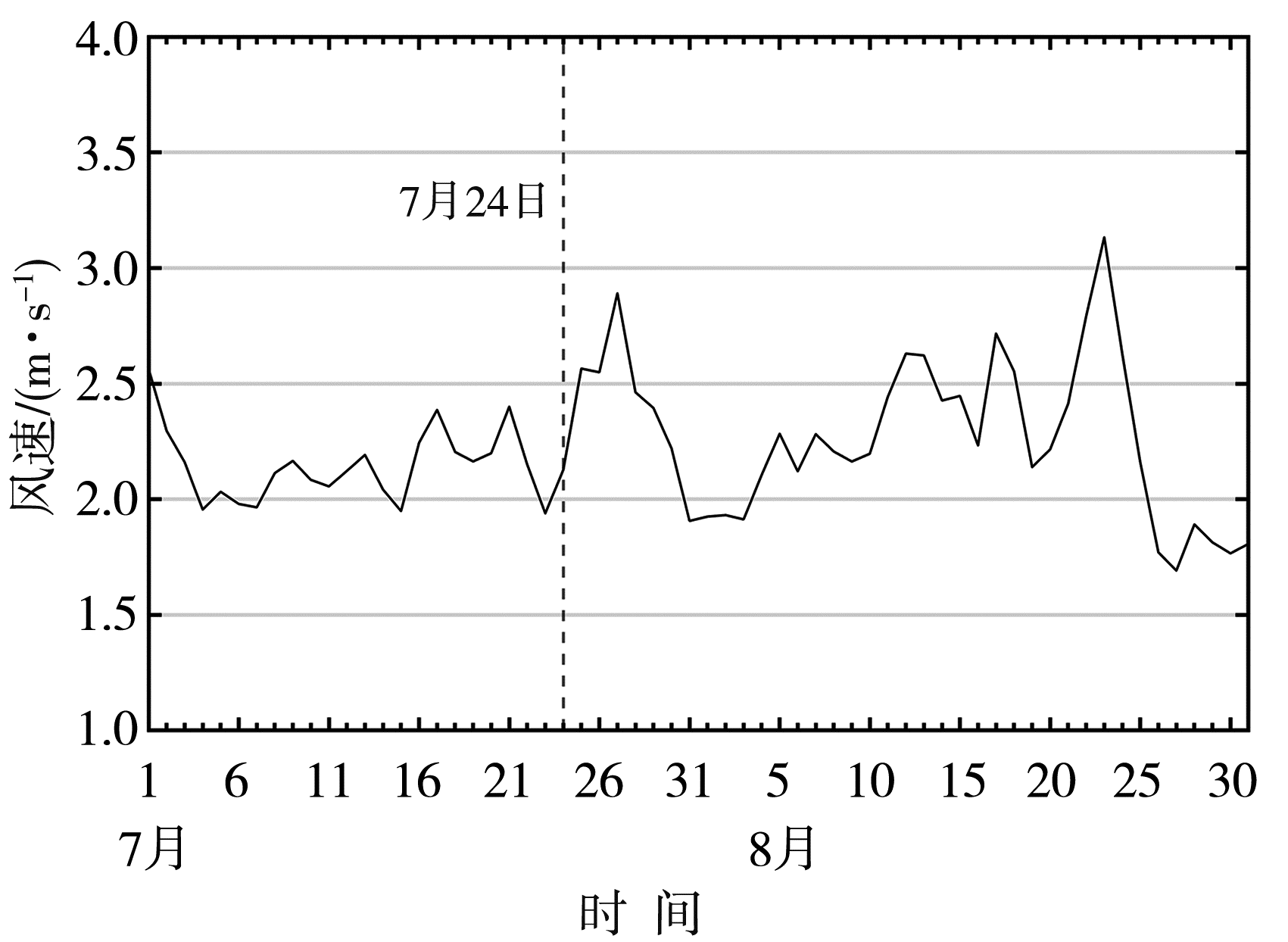干旱气象 ›› 2025, Vol. 43 ›› Issue (5): 678-688.DOI: 10.11755/j.issn.1006-7639-2025-05-0678
2024年7月美国加利福尼亚州山火与干旱和高温等极端气象条件的关系及大气环流成因
赵采玲1( ), 杨金虎1, 岳平1, 颜鹏程1(
), 杨金虎1, 岳平1, 颜鹏程1( ), 李忆平1, 李红1, 李丹华2
), 李忆平1, 李红1, 李丹华2
- 1.中国气象局兰州干旱气象研究所,甘肃省干旱气候变化与减灾重点实验室,中国气象局干旱气候变化与减灾重点实验室,甘肃 兰州 730020
2.兰州区域气候中心,甘肃 兰州 730020
-
收稿日期:2025-01-16修回日期:2025-04-14出版日期:2025-10-31发布日期:2025-11-09 -
通讯作者:颜鹏程(1987—),男,江苏盐城人,副研究员,主要从事气候预测研究。E-mail: yanpc@iamcma.cn。
-
作者简介:赵采玲(1989—),女,甘肃金昌人,副研究员,主要从事陆气相互作用研究。E-mail: zhaocl@iamcma.cn。 -
基金资助:气象能力提升联合研究专项重点项目(22NLTSZ003);国家自然科学基金项目(42375085);国家自然科学基金项目(42205050);国家自然科学基金项目(42375039)
The relationship between large-scale atmospheric circulations, extreme meteorological conditions, and the severe wildfire outbreak in California, USA during July 2024
ZHAO Cailing1( ), YANG Jinhu1, YUE Ping1, YAN Pengcheng1(
), YANG Jinhu1, YUE Ping1, YAN Pengcheng1( ), LI Yiping1, LI Hong1, LI Danhua2
), LI Yiping1, LI Hong1, LI Danhua2
- 1. Institute of Arid Meteorology, China Meteorological Administration, Key Laboratory of Arid Climate Change and Reducing Disaster of Gansu Province, Key Laboratory of Arid Climate Change and Reducing Disaster of CMA, Lanzhou 730020, China
2. Lanzhou Regional Climate Center, Lanzhou 730020, China
-
Received:2025-01-16Revised:2025-04-14Online:2025-10-31Published:2025-11-09
摘要:
2024年7月加州北部爆发的特大山火在极端高温与强风的共同作用下迅速蔓延,造成严重损失。本文利用美国干旱监测的干旱程度和面积指数(Drought Severity and Coverage Index,DSCI)、欧洲中期天气预报中心(European Centre for Medium-Range Weather Forecasts, ECMWF)发布的ERA5(ECMWF Reanalysis v5)再分析资料和美国国家海洋和大气管理局(National Oceanic and Atmospheric Administration,NOAA)提供的海温等多源数据,分析山火爆发前后的气象条件与环流背景,可为极端气候背景下山火预警与防控提供科学依据。结果表明:2024年7月加州山火爆发是极端气象条件导致的结果,持续数周的高温(日最高气温达32.1 ℃)、极低湿度(平均相对湿度<50%)和持续干旱(DSCI>26.0)使植被高度易燃。环流系统极端异常加剧了高温干旱,北美西海岸持续受高压环流控制,局地强风加速了山火的空间传播。2024年厄尔尼诺事件(Niño 3.4区正异常)通过遥相关作用增强高压系统,抑制冬季降水并延长干旱期,热带东太平洋暖海温使得哈德莱环流增强,加强了加利福尼亚州的下沉气流,最终形成“高温-低湿-干旱”的耦合模式,显著增加山火面积和持续时间。
中图分类号:
引用本文
赵采玲, 杨金虎, 岳平, 颜鹏程, 李忆平, 李红, 李丹华. 2024年7月美国加利福尼亚州山火与干旱和高温等极端气象条件的关系及大气环流成因[J]. 干旱气象, 2025, 43(5): 678-688.
ZHAO Cailing, YANG Jinhu, YUE Ping, YAN Pengcheng, LI Yiping, LI Hong, LI Danhua. The relationship between large-scale atmospheric circulations, extreme meteorological conditions, and the severe wildfire outbreak in California, USA during July 2024[J]. Journal of Arid Meteorology, 2025, 43(5): 678-688.

图1 美国加利福尼亚州州界范围(黑色实线)及地形(填色,单位:m) (红色圆点为起火点)
Fig.1 State boundary (black solid line) and topography (the color shaded, Unit: m) of California, USA (The red dot marks the wildfire ignition point)

图2 2024年6月29日—7月3日(a)、7月4—8日(b)、7月9—13日(c)、7月14—18日(d)、7月19—23日(e)500 hPa平均位势高度场(黑色等值线,单位:dagpm)和温度场(红色等值线,单位:℃)与1991—2020年气候态差值的空间分布 (实线为正值、虚线为负值)
Fig.2 The spatial distribution of differences between average geopotential height field (black contour lines, Unit: dagpm) and temperature field (red contour lines, Unit: ℃) at 500 hPa from June 29 to July 3 (a), July 4 to July 8 (b), July 9 to July 13 (c), July 14 to July 18 (d), July 19 to July 23 (e), 2024 and the climatological state from 1991 to 2020 (The solid lines denote positive anomalies, dashed lines denote negative anomalies)

图 3 2024年6月29日—7月3日(a)、7月4—8日(b)、7月9—13日(c)、7月14—18日(d)、7月19—23日(e)700 hPa平均比湿场(单位:kg·kg-1)与1991—2020年气候态差值的空间分布
Fig. 3 The spatial distribution of differences between the 700 hPa average specific humidity field (Unit: kg·kg-1) from June 29 to July 3 (a), July 4 to July 8 (b), July 9 to July 13 (c), July 14 to July 18 (d), July 19 to July 23 (e), 2024 and the climatological state from 1991 to 2020

图4 2024年6月29日—7月3日(a)、7月4—8日(b)、7月9—13日(c)、7月14—18日(d)、7月19—23日(e)平均垂直风场(箭头,单位:m·s-1)、水平风速(等值线,单位:m·s-1)和散度(彩色填色,单位:10-6 s-1)沿122°W的纬度-高度剖面
Fig.4 The latitude-time sections of the average vertical wind fields (arrows, Unit: m·s-1), total horizontal wind speed (contours, Unit: m·s-1), and divergence (the color shaded, Unit: 10-6 s-1) from June 29 to July 3 (a), July 4 to July 8 (b), July 9 to July 13 (c), July 14 to July 18 (d), July 19 to July 23 (e), 2024

图6 2024年加州DSCI周变化 (黑色虚线为山火爆发时间,下同)
Fig.6 Weekly variations of DSCI in California in 2024 (The black dashed line denotes the wildfire outbreak date, the same as below)

图7 2024年4—10月美国加州日平均气温、日最高气温、相对湿度(a)及降水量(b)逐日变化
Fig.7 Daily variations of mean temperature, daily maximum temperature, relative humidity (a) and precipitation (b) in California, USA from April to October 2024

图9 2024年7月23日(a)、31日(b)加州山火爆发前后气溶胶光学厚度(AOD)变化
Fig.9 Changes in aerosol optical depth (AOD) before and after the outbreak of wildfire in California on 23 (a) and 31 (b) July, 2024
| [1] | 郝立生, 何丽烨, 马宁, 等, 2023. 厄尔尼诺事件年际变化与我国华北夏季干旱的关系[J]. 干旱气象, 41(6): 829-840. |
| [2] |
胡海清, 陆昕, 孙龙, 等, 2016. 气温和空气相对湿度对森林地表细小死可燃物平衡含水率和时滞的影响[J]. 植物生态学报, 40(3): 221-235.
DOI |
| [3] |
李忆平, 张金玉, 岳平, 等, 2022. 2022年夏季长江流域重大干旱特征及其成因研究[J]. 干旱气象, 40(5): 733-747.
DOI |
| [4] | 彭道福, 乐旭, 朱君, 等, 2023. 2019—2020年北极野火极端事件的气象成因解析[J]. 气候与环境研究, 28(2): 195-206. |
| [5] | 田永丽, 王秋华, 2019. 气象条件异常对美国加利福尼亚州山火的影响[J]. 森林防火(3): 21-25. |
| [6] | 王健疆, 马浩, 余丽萍, 等, 2021. 2019年浙江省秋旱大气环流特征分析[J]. 干旱气象, 39(1): 1-7. |
| [7] | 吴东佑, 2024. 气象条件对极端野火烟尘气溶胶的影响及反馈效应研究[D]. 兰州: 兰州大学. |
| [8] |
颜鹏程, 李忆平, 曾鼎文, 等, 2024. 2024年4—6月我国区域性高温干旱特征及其影响因子[J]. 干旱气象, 42(4): 507-518.
DOI |
| [9] | 周煜, 2022. 不同ENSO位相下亚马逊地区野火气溶胶气候效应的研究[D]. 南京: 南京信息工程大学. |
| [10] | DONG L, LEUNG L R, QIAN Y, et al, 2021. Meteorological environments associated with California wildfires and their potential roles in wildfire changes during 1984-2017[J]. Journal of Geophysical Research: Atmospheres, 126(5): e2020JD033180. DOI: 10.1029/2020JD033180. |
| [11] |
FREEBORN P H, JOLLY W M, COCHRANE M A, 2016. Impacts of changing fire weather conditions on reconstructed trends in U.S. wildland fire activity from 1979 to 2014[J]. Journal of Geophysical Research: Biogeosciences, 121(11): 2 856-2 876.
DOI URL |
| [12] | GALANIS M, RAO K, YAO X L, et al, 2021. DamageMap: A post-wildfire damaged buildings classifier[J]. International Journal of Disaster Risk Reduction, 65: 102540. DOI: 10.1016/j.ijdrr.2021.102540. |
| [13] |
GIRARDIN M P, WOTTON B M, 2009. Summer moisture and wildfire risks across Canada[J]. Journal of Applied Meteorology and Climatology, 48(3): 517-533.
DOI URL |
| [14] | GOSS M, SWAIN D L, ABATZOGLOU J T, et al, 2020. Climate change is increasing the likelihood of extreme autumn wildfire conditions across California[J]. Environmental Research Letters, 15(9): 094016. DOI: 10.1088/1748-9326/ab83a7. |
| [15] |
GUMBER A, REID J S, HOLZ R E, et al, 2023. Assessment of severe aerosol events from NASA MODIS and VIIRS aerosol products for data assimilation and climate continuity[J]. Atmospheric Measurement Techniques, 16(10): 2 547-2 573.
DOI URL |
| [16] |
HE Q Q, ZHANG M, HUANG B, et al, 2017. MODIS 3 km and 10 km aerosol optical depth for China: Evaluation and comparison[J]. Atmospheric Environment, 153:150-162.
DOI URL |
| [17] | HERNANDEZ C, DROBINSKI P, TURQUETY S, 2015. Impact of wildfire-induced land cover modification on local meteorology: A sensitivity study of the 2003 wildfires in Portugal[J]. Atmospheric Research, 164: 49-64. |
| [18] |
HUANG B Y, THORNE P W, BANZON V F, et al, 2017. Extended reconstructed sea surface temperature, version 5 (ERSSTv5): Upgrades, validations, and intercomparisons[J]. Journal of Climate, 30(20): 8 179-8 205.
DOI URL |
| [19] |
JOLLY W M, COCHRANE M A, FREEBORN P H, et al, 2015. Climate-induced variations in global wildfire danger from 1979 to 2013[J]. Nature Communications, 6: 7537. DOI: 10.1038/ncomms8537.
PMID |
| [20] |
KUWAYAMA Y, THOMPSON A, BERNKNOPF R, et al, 2019. Estimating the impact of drought on agriculture using the U.S. drought monitor[J]. American Journal of Agricultural Economics, 101(1): 193-210.
DOI URL |
| [21] | MARTIN J T, PEDERSON G T, WOODHOUSE C A, et al, 2020. Increased drought severity tracks warming in the United States' largest river basin[J]. Proceedings of the National Academy of Sciences of the United States of America, 117(21): 11 328-11 336. |
| [22] |
MASS C F, OVENS D, 2019. The northern California wildfires of 8-9 October 2017: The role of a major downslope wind event[J]. Bulletin of the American Meteorological Society, 100(2): 235-256.
DOI URL |
| [23] | MORITZ M A, MORAIS M E, SUMMERELL L A, et al, 2005. Wildfires, complexity, and highly optimized tolerance[J]. Proceedings of the National Academy of Sciences of the United States of America, 102(50): 17 912-17 917. |
| [24] |
MUÑOZ-SABATER J, DUTRA E, AGUSTÍ-PANAREDA A, et al, 2021. ERA5-Land: A state-of-the-art global reanalysis dataset for land applications[J]. Earth System Science, Data, 13(9): 4 349-4 383.
DOI URL |
| [25] |
PASCHALIDOU A K, KASSOMENOS P A, 2016. What are the most fire-dangerous atmospheric circulations in the Eastern-Mediterranean? Analysis of the synoptic wildfire climatology[J]. Science of The Total Environment, 539: 536-545.
DOI URL |
| [26] | PENG X B, YU M, CHEN H S, et al, 2023. Projections of wildfire risk and activities under 1.5 ℃ and 2.0 ℃ global warming scenarios[J]. Environmental Research Communications, 5(3): 031002. DOI: 10.1088/2515-7620/acbf13. |
| [27] |
POLLINA J B, COLLE B A, CHARNEY J J, 2013. Climatology and meteorological evolution of major wildfire events over the northeast United States[J]. Weather and Forecasting, 28: 175-193.
DOI URL |
| [28] | ROTHERMEL R C, 1972. A mathematical model for predicting fire spread in wildland fuels[R]. Forest Service Research Paper, INT-115. Ogden, UT: U.S. Department of Agriculture, Intermountain Forest and Range Experiment Station: 40 p. |
| [29] |
RUNNING S W, 2006. Is global warming causing more, larger wildfires?[J]. Science, 313(5789): 927-928.
DOI URL |
| [30] |
SMITH K H, TYRE A J, TANG Z H, et al, 2020. Calibrating human attention as indicator: Monitoring #drought in the twittersphere[J]. Bulletin of the American Meteorological Society, 101(10): E1801-E1819.
DOI URL |
| [31] |
THOMPSON J R, SPIES T A, 2009. Vegetation and weather explain variation in crown damage within a large mixed-severity wildfire[J]. Forest Ecology and Management, 258(7): 1 684-1 694.
DOI URL |
| [32] | VAN OLDENBORGH G J, KRIKKEN F, LEWIS S, et al, 2021. Attribution of the Australian bushfire risk to anthropogenic climate change[J]. Natural Hazards and Earth System Sciences, 21(3): 941-960. |
| [33] |
WILLIAMS A P, ABATZOGLOU J T, GERSHUNOV A, et al, 2019. Observed impacts of anthropogenic climate change on wildfire in California[J]. Earth’s Future, 7(8): 892-910.
DOI URL |
| [1] | 胡跃鹏, 赵军平, 刘汉华, 付远, 孙善磊, 宋子祎. 2024年7—9月浙江省极端高温成因分析[J]. 干旱气象, 2025, 43(4): 499-509. |
| [2] | 付远, 刘汉华, 周玲丽, 赵军平, 马昊, 陆婷婷, 魏蕾, 宣卓林. 2022年与2013年浙江夏季极端高温特点和成因对比[J]. 干旱气象, 2025, 43(1): 76-87. |
| [3] | 郝立生, 何丽烨, 马宁, 郝钰茜. 厄尔尼诺事件年际变化与我国华北夏季干旱的关系[J]. 干旱气象, 2023, 41(6): 829-840. |
| [4] | 邓星辰, 于桐, 沈佳依, 赵欣, 王林, 郑飞. 2023/2024年厄尔尼诺事件对巴拿马运河区域干旱的影响分析[J]. 干旱气象, 2023, 41(6): 841-848. |
| [5] | 罗晓玲, 杨梅, 赵慧华, 李岩瑛, 蒋菊芳, 伏芬琪. 厄尔尼诺事件对甘肃武威温度降水以及气象干旱影响分析[J]. 干旱气象, 2023, 41(6): 849-859. |
| [6] | 马思源, 金燕, 张思, 王楚钦, 马志敏. 厄尔尼诺/南方涛动事件对云南秋季气象干旱的不同影响分析[J]. 干旱气象, 2023, 41(6): 860-872. |
| [7] | 林纾, 李红英, 黄鹏程, 段欣妤. 2022年夏季我国高温干旱特征及其环流形势分析[J]. 干旱气象, 2022, 40(5): 748-763. |
| [8] | 兰明才, 周莉, 蒋帅, 尹依雯, 许霖. 西太平洋副热带高压控制下湖南一次短时强降水成因分析[J]. 干旱气象, 2022, 40(4): 656-666. |
| [9] | 师锐, 何光碧, 周春花. 四川一次持续性暴雨过程的水汽特征及多尺度系统影响分析[J]. 干旱气象, 2021, 39(3): 415-425. |
| [10] | 王健疆, 马浩, 余丽萍, 龚理卿, 汪晨. 2019年浙江省秋旱大气环流特征分析[J]. 干旱气象, 2021, 39(1): 1-7. |
| [11] | 王孝慈, 李双君, 孟英杰. 2016—2020年6—7月长江流域主要暴雨过程特征及差异性分析[J]. 干旱气象, 2021, 39(06): 921-929. |
| [12] | 马浩, 刘昌杰, 钱奇峰, 徐哲永, 肖晶晶, 杨明, 高大伟. 2018年5月浙江省极端高温气候特征及环流背景[J]. 干旱气象, 2020, 38(6): 909-919. |
| [13] | 王孝慈, 李双君, 孟英杰. 2019年6—7月两湖流域雨情异常成因分析[J]. 干旱气象, 2020, 38(6): 937-946. |
| [14] | 李媛, 李瑞芬, 张熙. 不同分布型El Niño事件对山东次年夏季降水的影响#br#[J]. 干旱气象, 2019, 37(5): 762-770. |
| [15] | 刘嘉慧敏, 郑然, 娄盼星, 梁绵. 2017年7月陕西高温热浪天气成因及前期信号初探[J]. 干旱气象, 2019, 37(2): 233-242. |
| 阅读次数 | ||||||
|
全文 |
|
|||||
|
摘要 |
|
|||||


